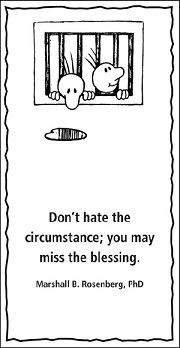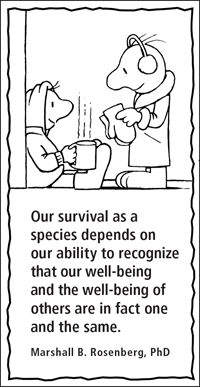2,000,000 COPIES SOLD WORLDWIDE * TRANSLATED IN MORE THAN 35 LANGUAGES
What is Nonviolent Communication™?
"Nonviolent Communication shows us a way of being very honest, without any criticism, insults, or put-downs, and without any intellectual diagnosis implying wrongness.”
Nonviolent Communication — also known as NVC and often called “compassionate communication” — helps you create the high quality of connection out of which people naturally enjoy contributing to one another’s well-being.
Dr. Marshall B. Rosenberg, Ph.D., travelled the world over for nearly 50 years teaching what Nonviolent Communication is by training people and mediating conflicts. He said that all over the world, in every culture, people are playing one of two games. One of those games was called "who is right and who is wrong?" The other game is called, "How can I make life more wonderful?"
When people experience a high quality of connection, they naturally want to play the latter of the two, and spontaneously feel motivated to create mutually beneficial outcomes.
When we feel connected we can enter into relationships of "power-with" rather than "power-over" — and we can use our Nonviolent Communication skills to facilitate the mutual understanding that can take us to win-win outcomes. Sometimes, the easiest way to understand what Nonviolent Communication is, is to take a look at what it isn’t….
What is Violent Communication?
Violent communication is what Dr. Rosenberg referred to as "life-disconnected, life-alienated thinking and language." It is precisely this way of thinking and speaking that takes us away from the quality of connection for which we are looking.
Violent communication can be seen as the opposite of what Nonviolent Communication is, because it is based on judgment, criticism, labeling and pigeon-holing others, avoiding responsibility and blaming, placing demands, threatening, and having rigid concepts of rightness and wrongness.
Violent communication uses static language — in other words, the verb "to be" — in order to know who is what and especially who is right and who is wrong, so that then we know who deserves to be rewarded and punished! Nonviolent Communication, on the other hand, is a process language which teaches you to be in the moment and connect with the deeper values and needs driving people's words and behavior rather than any intellectual diagnosis of "wrongness."
NVC teaches you how to speak your truth or share your perspective in a way that is most likely to lead to harmony than conflict. And it teaches you how to be in the face of uncomfortable statements — like blame, judgment, criticism, or a verbal attack — and listen for the values and needs behind the statement. As a result you are less defensive, are able to stand in a more compassionate place, and are much more likely to defuse any potential conflict.
Keep reading if you want to learn more about Nonviolent Communication (NVC), and how you can apply it in the important relationships in your life.
The Nonviolent Communication Model
The Nonviolent Communication model is the symbiotic integration of four main components:
- Consciousness - A set of principles and perspectives that support living a life of compassion, collaboration, courage, and authenticity both within ourselves and in our interactions with family, friends, coworkers, or anyone else with whom we might interact;
- Language - Understanding how our words, as well as the words of others contribute to either connection or distance, helping or hurting, compromise or conquest in an interaction or situation;
- Communication - Knowing how to ask for what we want without threatening, demanding or coercing, how to hear others (even in the course of a disagreement) without absorbing self-criticism or blame, and how to move toward mutually beneficial and positive outcomes for all parties involved in an interaction or situation;
- Means of Influence - Learning how to share our power with others instead of using our power over others, in order to facilitate an environment where all parties feel equally honored, valued, respected, and safe.
The Nonviolent Communication model can be effectively employed to enrich and nurture parenting & familial relations, friendships & relationships, workplace interactions, the educational process, and any other situation in which we interact with others. Using the Nonviolent Communication model in our everyday lives can help facilitate an empathic and supportive emotional environment for ourselves and those we value.
Nonviolent Communication: A Language of Life by Marshall Rosenberg Ph.D.
"Human beings have enormous power to enrich life. We can use words to contribute to people’s enjoyment, their wisdom. We can use words that can make life miserable for people. So our words are very powerful. We can touch people in ways that give great pleasure, great nurturing, support. We are powerhouses, and there’s nothing we enjoy doing more than to use that power we have to enrich lives. So isn’t it wonderful that we have this power and the joy it brings when we use it? That’s to be celebrated. Wow! And the more we celebrate that, the less we will be willing to do anything else."
Nonviolent Communication: A Language of Life by Marshall Rosenberg Ph.D. is the final literary offering from the visionary peacemaker who ushered in the compassionate communication movement worldwide. This bestselling book has sold over one million copies and has been translated into over 30 languages to date. Nonviolent Communication: A Language of Life, is chock-full of engaging stories, tangible examples, and anecdotal information about the core components of the compassionate communication process and its effect on human consciousness. You can purchase a copy of Nonviolent Communication: A Language of Life, by Marshall Rosenberg Ph.D., in our webstore as well as other works of literature that can help you construct the framework for healthy, happy, and safe communication in your life and the lives of others.
The Nonviolent Communication Process
Any communication model has at least two parts: speaking and listening, also known as giving and receiving. In NVC we call these "honesty" and "empathy."
The Nonviolent Communication process consists of four components. Each of these four falls under empathy (how I listen) as well as under honesty (authentic and genuine self-expression). Because communication involves your own as well as the other person's perception, worldview, and interpretations, we use honesty and empathy to create a "dance of connection" — in which we use our Nonviolent Communication skills to exchange the information necessary to both feel more connected and bring about outcomes that are mutually beneficial.
The four components of the Nonviolent Communication process are:
- Observations - How your perceptual observations and the observations of others — the neutral facts — provide a foundation to know what are we talking about — and eliminate confusion about the particular stimulus in any given situation or interaction;
- Feelings - The information our body and mind give us regarding whether our values and needs are fulfilled in a given interaction. They provide a powerful point of connection to help us understand another's experience, or communicate our own;
- Needs - Universal Human Needs also known as core human motivators; when you distill any conflict to the level of Universal Human Needs, now people can see each others' humanity which begins the healing and reconciliation process and provides a solid foundation for win-win solutions;
- Requests - Taking responsibility for what we actually want by expressing a request rather than a demand. Hearing another's request as such, and knowing that we still have choice.
Click here to learn more about the four part Nonviolent Communication process here.
The Puddledancer Press Nonviolent Communication Book Store
Puddledancer Press is the premier publisher of Nonviolent Communication literature. We are committed to assisting people of all cultures, nationalities, and walks-of-life on their self-transformation and self-improvement journey.
Featuring the late Dr. Marshall Rosenberg’s groundbreaking Nonviolent Communication book, A Language of Life, the Puddledancer Press book store is loaded with resources to help you positively transform your thoughts, behaviors, and actions by incorporating compassionate communication techniques in your interactions with family, friends, coworkers, or anyone else you come into contact with on any given day. You can browse our new improved web store to choose the Nonviolent Communication book that best suits your needs.
If you have any Nonviolent Communication book inquiries, or any questions whatsoever about what Nonviolent Communication is, please contact us directly.

Upon becoming CEO of Microsoft, Nadella asked his top executives to read Marshall Rosenberg’s Nonviolent Communication “Why else is empathy important? Nadella states: You have to be able to say, ‘Where is this person coming from?'” he says. “‘What makes them tick? Why are they excited or frustrated by something that is happening, whether it’s about computing or beyond computing?’”
"In our present age of uncivil discourse and mean-spirited demagoguery, the principles and practices of Nonviolent Communication are as timely as they are necessary to the peaceful resolution of conflicts, personal or public, domestic or international."
MIDWEST BOOK REVIEW, Taylor’s Shelf




